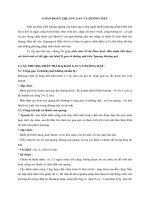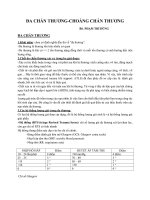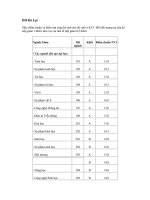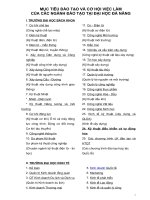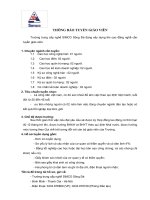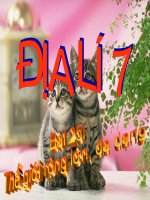Thionline1 unit10 DA
Bạn đang xem bản rút gọn của tài liệu. Xem và tải ngay bản đầy đủ của tài liệu tại đây (77.94 KB, 13 trang )
Mark the letter A, B, C, or D on your answer sheet to indicate the word whose underlined part differs from the other
three in pronunciation in each of the following questions.
Câu 1.
A
earnED
B
lookED
C
ovED
D
preferrED
Đáp án B. looked, phát âm là /t/, còn lại phát âm là /d/ A. Earned /ɜːrnd/
(v) kiếm tiền B. Looked /lʊkt/ (v) nhìn C. Moved /muːvd/ (v) di chuyển
D. Preferred /prɪˈfɜːrd/ (v) thích hơn
Câu 1
Câu 2.
A
fAme
B
bAby
C
mAny
D
plAne
Đáp án C. many, phát âm là /e/, còn lại phát âm là /eɪ/ A. Fame /feɪm/ (n)
danh vọng B. Baby /ˈbeɪbi/ (n) trẻ nhỏ C. Many /ˈmeni/ nhiều D. Plane
/pleɪn/ (n) máy bay
Câu 2
Mark the letter A, B, C, or D on your answer sheet to indicate the correct answer to each of the following questions
Câu 1. It gets _______ when the winter is coming.
A
cold and cold
B
the coldest and coldest
C
more and more cold
D
colder and colder
Đáp án D Giải thích: Get/ become + so sánh hơn and so sánh hơn: càng
ngày càng…hơn Vì cold là tính từ ngắn nên khi chuyển sang so sánh hơn
ta thêm er mà không thêm more vào trước. Dịch nghĩa: khi mùa đông
đến, trời càng ngày càng lạnh.
Câu 1
Câu 2. _________ saying was so important that I asked everyone to stop talking and listen.
A
That the woman was
B
The woman was
C
What the woman was
D
What was the woman
Câu 2
Đáp án C Giải thích: That S V: việc ai đó làm gì - được coi là một cụm
danh từ và có chức năng như chủ ngữ What S V: Điều mà… - được coi
như một cụm danh từ, ta không đảo tobe hay trợ động từ như câu hỏi vì
đây là một cụm danh từ sử dụng từ để hỏi chứ không phải câu hỏi. So…
that…: quá…đến nỗi mà Dịch nghĩa: Điều mà cô ấy đang nói quan trọng
đến mức tôi yêu cầu tất cả mọi người cùng yên lặng lắng nghe.
Câu 3. A ________ problem, feeling, or belief is difficult to change because its causes have been there for a long time.
A
deep-seated
B
significant
C
dependent
D
intellectual
Đáp án A Giải thích: A. Deep-seated (adj) cố định, mạnh mẽ, khó mà
thay đổi B. Significant (adj) đặc biệt C. Dependent (adj) độc lập, riêng
biệt D. Intellectual (adj) trí tuệ Dịch nghĩa: Những vấn đề lâu dài, những
niềm tin và cảm xúc mạnh mẽ thường rất khó để thay đổi vì hậu quả của
nó đã diễn ra trong thời gian dài rồi.
Câu 3
Câu 4. Let's go to see that famous film, ____ we?
A
don't
B
shall
C
won't
D
will
Đáp án B Giải thích: Câu hỏi đuôi cho let’s luôn là shall we? Dịch nghĩa:
Hãy cùng đi xem bộ phim nổi tiếng đó, được không?
Câu 4
Câu 5. No sooner ____ than Mary came over.
A
has John gone out
B
John has gone out
C
had John gone out
D
have John gone out
Đáp án C Giải thích: No sooner had S Vpp than S Vqk: Ngay khi …
thì… Dịch nghĩa: Ngay khi John ra ngoài thì Mary đến.
Câu 5
Câu 6. I was surprised at ____ yesterday.
A
how cold it was
B
how was it cold
C
how cold was it
D
how it was cold
Đáp án A Giải thích: Bình thường với các câu hỏi dùng từ để hỏi ta
thường đảo tobe hoặc trợ động từ lên trước chủ ngữ, nhưng khi thành lập
cụm danh từ với từ để hỏi thì ta giữ nguyên trật tự như câu trần thuật mà
không cần trợ động từ: tương tự như câu 9 What the woman was saying
Nhưng với câu nói về tính chất và sử dụng How thì ta đảo tính từ hoặc
phó từ lên và dùng How adj/ adv S V Dịch nghĩa: Tôi rất ngạc nhiên về
mức độ trời lạnh hôm qua.
Câu 6
Câu 7. He would still be alive today if he_________ that drug when he was in Spain.
A
weren't taking
B
hadn't taken
C
wouldn't take
D
didn't take
Đáp án B Giải thích: Ta hiểu nội dung câu nói là: Nếu anh ta không chơi
thuốc thì bây giờ anh ta vẫn sống. Như vậy việc thử thuốc là hành động
quá khứ, còn giả sử anh ta vẫn sống là ở hiện tại, ta dùng câu điều kiện
hỗn hợp loại III – II. If S had (not) Vpp, S would (not) V. Dịch nghĩa:
Nếu anh ta không chơi thuốc khi ở Tây Ban Nha thì hôm nay anh ta vẫn
còn sống.
Câu 7
Câu 8. Yuri Gagarin was the first person ________into space.
A
travelling
B
has travelled
C
to travel
D
travelled
Đáp án C Giải thích: The first/ second/ last… to V: người đầu tiên, thứ
hai, cuối cùng làm gì Dịch nghĩa: Yuri Gagarin là người đầu tiên du hành
vũ trụ.
Câu 8
Câu 9. To preserve that ________, it was necessary to preserve the people that had created it.
A
civilize
B
civilization
C
civility
D
civil
Đáp án B Giải thích: A. Civilize (v) văn minh hóa, cải thiện xã hội B.
Civilization (n) nền văn minh C. Civility (n) phép lễ độ D. Civil (adj) liên
quan đến công dân Chỗ cần điền một danh từ, về nghĩa ta chọn được B
Dịch nghĩa: Để bảo tồn nền văn minh đó, việc cần thiết là phải bảo vệ
những con người đã sáng lập ra nó.
Câu 9
Câu 10. _______ is a situation in which large numbers of people have little or no food, and many of them die.
A
Disaster
B
Famine
C
Poverty
D
Flood
Đáp án B Giải thích: A. Disaster: thảm họa B. Famine: nạn đói C.
Poverty: sự nghèo đói D. Flood: lũ lụt Dịch nghĩa: Nạn đói là tình trạng
mà rất nhiều người đều chỉ có rất ít hoặc là không có thức ăn và nhiều
người trong số đó phải chết đói.
Câu 10
Câu 11. In _______ 22nd SEA Games, Vietnam won 158 _______ gold medals.
A
Ø / the
B
the / Ø
C
a / the
D
the / the
Câu 11
Đáp án B Giải thích: Trước số thứ tự luôn dùng the, khi dùng số đếm thì
không có mạo từ the. Dịch nghĩa: Trong SEAGAME lần thứ 22, Việt
Nam giành được 168 huy chương vàng.
Câu 12. The woman _______ when the police told her that her son had died.
A
broke in
B
broke into
C
broke down
D
broke away
Đáp án C Giải thích: A. Break in: đột nhập vào tòa nhà B. Break into:
đột nhập vào tòa nhà C. Break down: suy sụp, ngất đi D. Break away:
bỏ trốn, vượt ngục Dịch nghĩa: Người phụ nữ suy sụp khi cảnh sát nói
rằng con trai của bà ấy đã chết rồi.
Câu 12
Câu 13. When morning came, the scene of where the bomb had fallen was one of utter _____.
A
damage
B
disruption
C
devastation
D
disturbance
Đáp án C Giải thích: A. Damage: hư hại B. Disruption: gián đoạn C.
Devastation: phá hủy D. Disturbance: cản trở Vì là hậu quả của vụ nổ
bom nên ta dùng từ mang nghĩa mạnh nhất là devastation. Hơn nữa utter
cũng là phó từ để nhấn mạnh tính “cực độ” của sự việc và thường đi kèm
với devastation. Dịch nghĩa: Khi trời sáng, khung cảnh nơi vụ nổ bom diễn
ra là một sự tàn phá khủng khiếp.
Câu 13
Câu 14. Nuance: “Is there anything I can do for you, sir?” - Rue: “_______.”
A
Ok, your time
B
Sure, go ahead, please
C
Yes, you’re welcome
D
Not now. Thanks anyway
Đáp án D Giải thích: A. Ok, your time: Ok đến lúc của bạn rồi B. Sure,
go ahead, please: Chắc chắn rồi, cứ tiếp tục đi C. Yes, you’re welcome:
vâng, không có gì (dùng đáp lại lời cảm ơn) D. Not now. Thanks anyway:
Không phải bây giờ, dù sao cũng cảm ơn Câu A và B có thể đúng nghĩa
nhưng không lịch sự, nếu muốn người khác giúp thì cũng phải nhờ một
cách lịch sự hơn. Chẳng hạn Could you help me…? Can you…? Would
you mind…? Dịch nghĩa: - Có việc gì tôi có thể làm giúp bạn không? Không phải bây giờ, dù sao cũng cảm ơn nhé.
Câu 14
Câu 15. Nam: “Hello, I’d like to book a room for the nights of the 18th and 19th.” Milan: “_______”
A
At your service.
B
What can I do for you?
C
What’s the matter?
D
Just a minute, please.
Câu 15
Đáp án D Giải thích: A. At your service: Tự phục vụ nhé B. What can I
do for you? Tôi có thể làm gì cho bạn? C. What’s the matter? Chuyện gì
thế? D. Just a minute, please: Đợi một phút Dịch nghĩa: - Xin chào, tôi
muốn đặt phòng trong đêm 18 và 19. - Làm ơn đợi một chút
Câu 16. This book is not really ________. It is a waste of money buying it.
A
inform
B
information
C
informative
D
informatively
Đáp án C Giải thích: A. Inform: (v) thông báo B. Information: (n) thông
tin C. Informative: (adj) nhiều thông tin D. Informatively: (adv) “không
hay dùng” Sau tobe ta điền danh từ hoặc tính từ, nhưng về nghĩa thì trong
trường hợp này danh từ information không phù hợp. Dịch nghĩa: Quyển
sách này không có nhiều thông tin. Thật là lãng phí tiền khi mua.
Câu 16
Câu 17. I first met her two years ago when we ______ at Oxford University.
A
had been studying
B
were studying
C
have been studying
D
are studying
Đáp án B Giải thích: - Thì quá khứ hoàn thành tiếp diễn had been V_ing:
Dùng để diễn tả hành động đã xảy ra được 1 thời gian nhưng trước một
hành động khác trong quá khứ. Ví dụ: Hôm qua khi tôi đến bữa tiệc thì
họ đã đang dùng bữa trước đó rồi, và vẫn đang dùng. Vậy hành động
dùng bữa đó sẽ chia ở quá khứ hoàn thành tiếp diễn. - Thì quá khứ tiếp
diễn: was/were V_ing: diễn tả hành động đang xảy ra tại một mốc thời
gian cụ thể trong quá khứ. Ví dụ: Lúc 7h sáng hôm qua tôi đang ăn sáng.
- Về nghĩa: Việc gặp gỡ diễn ra khi họ đang học. Hành động dài diễn ra
ta dùng quá khứ tiếp diễn, bị một hành động ngắn khác cắt ngang ta dùng
quá khứ đơn. Dịch nghĩa: Tôi gặp cô ấy hai năm trước khi chúng tôi đang
học ở Oxford.
Câu 17
Câu 18. We found the exam extremely easy. We ________ so hard.
A
needn't study
B
needn't be studying
C
needn't have studied
D
needn't have been studied
Đáp án C Giải thích: Find something adj: thấy cái gì như thế nào Needn’t
have Vpp: không cần làm gì nhưng thực tế thì đã làm Việc học là con
người học – dùng chủ động, phương án D chia ở bị động nên sai. Dịch
nghĩa: Chúng tôi thấy bài thi cực dễ. Lẽ ra chúng ta không cần phải học
chăm như vậy.
Câu 18
Câu 19. My parents always let me ____ what I think I should."
A
doing
B
did
C
did
D
do
Câu 19
Đáp án D Giải thích: Let S V: cho phép ai đó làm gì Dịch nghĩa: Cha mẹ
luôn cho phép tôi làm những điều mà tôi nghĩ là nên làm.
Mark the letter A, B, C or D on your answer sheet to indicate the word(s) CLOSEST in meaning to the underlined
word(s) in each of the following questions.
Câu 1. An international medical conference initiated by Davison resulted in the birth of the League of Red Cross Societies in
1991.
A
treated
B
dedicated
C
helped
D
started
Đáp án D Giải thích: Initiate: bắt đầu A. Treat: đối xử B. Dedicate: cống
hiến C. Help: giúp đỡ D. Start: khởi động, bắt đầu Dịch nghĩa: Một hội
nghị y tế quốc tế khởi xướng bởi Davison dẫn đến sự ra đời của Liên
đoàn các Hội Chữ thập đỏ xã hội trong năm 1991.
Câu 1
Câu 2. We’ll have to use the restrooms on the next floor because the ones on this floor are not in working condition.
A
out of order
B
out of work
C
run out of
D
torn down
Đáp án A Giải thích: Tobe not in working condition: k hoạt động, hỏng A.
Tobe out of order: không hoạt động, hỏng B. Tobe out of work: thất
nghiệp C. run out of: hết D. tear down: phá cổng, tường thành Dịch nghĩa:
Chúng ta sẽ phải sử dụng phòng nghỉ ở tầng bên bởi vì một phòng trong
tầng này bị hỏng rồi.
Câu 2
Câu 3. The venom of coral snakes is especially potent and the mortality rate among humans who have been bitten is high.
A
contagious
B
powerful
C
abundant
D
impure
Câu 3
Đáp án B Giải thích: Potent: (adj) có sức mạnh A. contagious (adj)
truyền nhiễm B. powerful (adj) có sức mạnh C. abundant (adj) thừa thãi
D. impure (adj) ô uế, bẩn Dịch nghĩa: Nọc độc của rắn san hô đặc biệt
mạnh và tỷ lệ tử vong ở người đã bị cắn rất cao.
Mark the letter A, B, C, or D on your answer sheet to indicate the underlined part that needs correction in each of
the following questions.
Câu 1. Much children like to get their faces painted with bright colors at community fairs.
A
like to
B
Much
C
painted with
D
their
Đáp án B. much => Many Giải thích: Children là danh từ đếm được nên
dùng many mà không dùng much. Dịch nghĩa: Nhiều trẻ em muốn được
tô mặt với những màu tươi sáng trong những dịp sinh hoạt cộng đồng.
Câu 1
Câu 2. Between all the photographs she showed me, there was only one of her husband
A
between
B
the
C
me
D
one
Đáp án A. between => Among Giải thích: Chỉ dùng between giữa hai đối
tượng, khi từ ba đối tượng trở lên ta dùng tư among. Dịch nghĩa: Trong số
tất cả các bức ảnh mà cô ấy cho tôi xem, chỉ có một bức là của chồng cô
ấy.
Câu 2
Câu 3. The letters written by the man was translating into Vietnamese by my sister.
A
into
B
written
C
by my sister
D
was translating
Lời giải :
. Đáp án D. was translating => was translated Giải thích: Những lá thư
được dịch sang tiếng Việt – dùng bị động tobe Vpp mới đúng. Dịch nghĩa:
Những lá thư viết bởi người đàn ông đó được dịch sang tiếng Việt bởi chị
của tôi.
Câu 3
Câu 4. Some bacteria are extremely harmful, but others are regular used in producing foods.
A
extremely harmful
B
Producing foods
C
Some bacteria
D
regular used
Đáp án D. regular used => regularly used Giải thích: Ta dùng phó từ để
bổ sung cho động từ. Dịch nghĩa: Một số vi khuẩn cực kì độc hại, nhưng
một số thì lại được sử dụng thường xuyên trong việc chế biến thức ăn.
Câu 4
Câu 5. There are many ways to do this exercise but mine is the best good one.
A
ways
B
are
C
mine
D
best good
Đáp án D. best good => best Giải thích: So sánh hơn nhất của từ good là
best, nên ở đây thừa từ good. Dịch nghĩa: Có nhiều cách để tập thể dục
nhưng cách của tôi là tốt nhất.
Câu 5
Mark the letter A, B, C, or D on your answer sheet to indicate the word(s) OPPOSITE in meaning to the underlined
word(s) in each of the following questions.
Câu 1. "Don't be such a pessimist. I'm sure you'll soon get over it. Cheer up!"
A
optimist
B
feminist
C
hobbyist
D
activist
Đáp án A Giải thích: Pessimist: người bi quan A. optimist (n) người lạc
quan B. feminist (n) người ủng hộ nữ giới C. hobbyist (n) người rất ham
mê một thú vui D. activist (n) nhà hoạt động
Câu 1
Câu 2. "Be quick! We must speed up if we don’t want to miss the flight. "
A
put forward
B
look up
C
slow down
D
turn down
Đáp án C Giải thích: speed up: tăng tốc A. put forward (v) đẩy lịch lên,
cho sự kiện diễn ra trước dự định B. look up: tra cứu C. slow down:
chậm lại D. turn down: từ chối Dịch nghĩa: Nhanh lên! Chúng ta phải tăng
tốc lên nếu chúng ta không muốn bỏ lỡ chuyến bay.
Câu 2
Read the following passage and mark the letter A, B, C, or D on your answer sheet to indicate the word or phrase
that best fits each of the numbered blanks from 35 to 44.
In Korea, in former days the marriage between a man and woman represented the joining of two families, rather (35)_____ the
joining of two individuals. The event (36)_____ Taerye (Great Ritual), and people from all over the village or neighborhood
participated. The ceremonies and events surrounding the actual marriage were long and (37)_____ . Professional matchmakers
paired up likely candidates for marriage, with the new couple often meeting for the first time at their wedding. The families
considered many factors in the decision, consulting with fortune tellers for (38)_____ about the couple's future life together.
During the Chosun period, people married (39)_____ their early teens, with the girl often being several years older than the boy.
The groom usually traveled to the house of the bride for the ceremony, then stayed there for three days (40)_____ taking his
new bride to his family's home. The actual ceremony involved many small rituals, with many bows and symbolic gestures. The
(41)_____ were expected to control their emotions and remain somber. (42)_____ Koreans have kept several aspects of the
traditional ceremony, most modern ceremonies resemble Western marriage ceremonies more than (43)_____ Korean ones.
However, many folk villages and museums across the country regularly perform ceremonies to (44)_____ the traditions alive.
Câu 1.
A
more
B
as
C
than
D
more than
Đáp án C Giải thích: rather than: thay vì
Câu 1
Câu 2.
A
often called
B
was often called
C
is often called
D
has often called
Đáp án B Giải thích: Sự kiện này được gọi là Taerye – dùng bị động tobe
Vpp Sự việc diễn ra ở quá khứ nên dùng thì quá khứ đơn.
Câu 2
Câu 3.
A
elaborate
B
elaboration
C
elaborately
D
elaborateness
Đáp án A Giải thích: Ta dùng tính từ đằng sau tobe để chỉ đặc điểm của
sự vật, tương tự như từ long. A. Elaborate (adj) kĩ lưỡng, tỉ mỉ B.
Elaboration (n) bài miêu tả chi tiết C. Elaborately (adv) một cách tỉ mỉ D.
Elaborateness (n) sự tỉ mỉ
Câu 3
Câu 4.
A
predictions
B
situations
C
evaluations
D
attentions
Đáp án A Giải thích: A. Predictions: suy đoán B. Situations: tình huống C.
Evaluations: đánh giá D. Attentions: sự chú ý
Câu 4
Câu 5.
A
in
B
for
C
on
D
from
Đáp án A Giải thích: Khi nói về tuổi ta dùng giới từ in : in their teens,
adulthood…
Câu 5
Câu 6.
A
ago
B
before
C
then
D
soon
Đáp án B Giải thích: Thời gian + ago: … trước Ví dụ: one year ago: một
năm trước Before N/V_ing/ mệnh đề: trước khi… Soon: sớm Nếu dùng
Câu 6
then thì cách sử dụng của nó tương đương với and, ta vẫn chia động từ
bình thường mà không dùng V_ing như khi dùng với before.
Câu 7.
A
participants
B
contests
C
examiners
D
competitors
Đáp án A Giải thích: A. Participant: người tham gia B. Contest: kì thi C.
Examiner: giám thị D. Competitor: thí sinh Ở đây tác giả chỉ những người
tham dự đám cưới đó, không phải cuộc thi gì cả.
Câu 7
Câu 8.
A
If only
B
As though
C
As
D
Although
Đáp án D Giải thích: A. If only: chỉ khi B. As though: như là C. As: vì D.
Although: mặc dù
Câu 8
Câu 9.
A
ancient
B
old
C
traditional
D
antique
Đáp án C Giải thích: A. Ancient: cổ đại B. Old: già cũ C. Traditional:
truyền thống D. Antique: đồ cổ Modern và traditional thường dùng như
cặp từ trái nghĩa hơn là modern và old/ ancient
Câu 9
Câu 10.
A
grip
B
catch
C
hold
D
keep
Câu 10
Đáp án D Giải thích: Keep something adj: giữ cho cái gì thế nào
Read the following passage and mark the letter A, B, C, or D on your answer sheet to indicate the correct answer to
each of the questions from 45 to 54.
Many ants forage across the countryside in large numbers and undertake mass migrations; these activities proceed because one
ant lays a trail on the ground for the others to follow. As a worker ant returns home after finding a source of food, it marks the
route by intermittently touching its stinger on the ground and depositing a tiny amount of trail pheromone - a mixture of chemicals
that delivers diverse messages as the context changes. These trails incorporate no directional information and may be followed
by other ants in either direction. Unlike some other messages, such as the one arising from a dead ant, a food trail has to be kept
secret from members of other species. It is not surprising then that ant species use a wide variety of compounds as trail
pheromones. Ants can be extremely sensitive to these signals. Investigators working with the trail pheromone of the leafcutter ant
Attatexana calculated that one milligram of this substance would suffice to lead a column of ants three times around Earth. The
vapor of the evaporating pheromone over the trail guides an ant along the way, and the ant detects this signal with receptors in its
antennae. A trail pheromone will evaporate to furnish the highest concentration of vapor right over the trail, in what is called a
vapor space. In following the trail, the ant moves to the right and left, oscillating from side to side across the line of the trail itself,
bringing first one and then the other antenna into the vapor space. As the ant moves to the right, its left antenna arrives in the
vapor space. The signal it receives causes it to swing to the left, and the ant then pursues this new course until its right antenna
reaches the vapor space. It then swings back to the right, and so weaves back and forth down the trail.
Câu 1. What is possibly the main topic of the passage?
A
The information contained in pheromones
B
The mass migration of ants
C
How ants mark and follow a chemical trail
D
Different species of ants around the world
Lời giải :
Dịch nghĩa: Đâu là chủ đề chính của bài viết? A. Thông tin được chứa
đựng trong pheromone B. Những cuộc di cư của bầy kiến C. Kiến đã
đánh dấu và lần theo đường mòn hóa chất như thế nào D. Các loài kiến
khác nhau trên thế giới Giải thích: Đoạn 1 giới thiệu chung về việc kiến
đánh dấu đường đi bằng chất pheromone, đoạn 2 nói về hiệu quả của
chất đó và đoạn 3 nói chi tiết cách mà kiến nhận biết và vận dụng chất đó
thế nào. Như vậy phương án C là bao quát nhất.
Câu 1
Câu 2. The word "forage" in line 1 is closest in meaning to________.
A
look up
B
search for food
C
walk toward
D
revolve around
Lời giải :
Dịch nghĩa: Từ "forage" – tìm kiếm, săn thức ăn - ở đoạn 1 gần nghĩa nhất
với________. A. tra cứu B. tìm kiếm thức ăn C. đi bộ tới D. tập trung
Câu 2
Câu 3. The word "intermittently" is closest in meaning to________.
A
incorrectly
B
rapidly
C
periodically
D
roughly
Lời giải :
Dịch nghĩa: Từ "intermittently" – không liên tục – gần nghĩa nhất
với________. A. k chính xác B. nhanh chóng C. tạm thời D. khắc nghiệt
Câu 3
Câu 4. The phrase "the one" refers to a single________.
A
dead ant
B
message
C
species
D
food trail
Lời giải :
Dịch nghĩa: Cụm từ "the one" nhắc đến________. A. kiến chết B. tin
nhắn C. loài D. chuỗi thức ăn Giải thích: Thông tin nằm ở đoạn 2 “Unlike
some other messages, such as the one arising from a dead ant, a food
trail has to be kept secret from members of other species” –Không giống
các lời nhắn khác, chẳng hạn như cái mà xuất phát từ việc một con kiến
chết, chuỗi thức ăn phải được giữ bí mật khỏi các thành phần loài khác.
Như vậy dịch nghĩa ra ta biết được the one đó thay thế cho từ message
Câu 4
Câu 5. According to the passage, why do ants use different compounds as trail pheromones?
A
To protect their trail from other species.
B
To reduce their sensitivity to some chemicals.
C
To attract different types of ants.
D
To indicate how far away the food is.
Lời giải :
Dịch nghĩa: Theo bài văn, tại sao kiến lại sử dụng tổng hợp nhiều loại
pheromone khác nhau? A. Để bảo vệ con đường này khỏi các loài khác
B. Để giảm độ nhạy cảm với một số chất hóa học C. Để thu hút những
loài kiến khác D. Để chỉ ra thức ăn xa thế nào Giải thích: Thông tin nằm ở
đoạn 2 “a food trail has to be kept secret from members of other species.
It is not surprising then that ant species use a wide variety of compounds
as trail pheromones.”
Câu 5
Câu 6. The author mentions the trail pheromone of the leafcutter ant in the second paragraph to point out________.
A
how little pheromone is needed to mark a trail
B
the different types of pheromones ants can produce
C
that certain ants can produce up to one milligram of
pheromone
D
a type of ant that is common in many parts of the
world
Lời giải :
Dịch nghĩa: Tác giả đề cập đến con đường pheromone của loài kiến cắt lá
trong đoạn 2 để chỉ ra________. A. cần rất ít pheromone để đánh dấu
một con đường B. các loại pheromone khác nhau mà kiến có thể tạo ra
C. rằng một số loài kiến nhất định có thể tạo ra đến 1g pheromone D.
loài kiến phổ biến khắp thế giới Giải thích: Tác giả lấy ví dụ 1g
pheromone có thể dẫn được đoàn kiến dài gấp 3 lần trái đất. Như vậy,
mục đích để chỉ một lượng rất ít pheromone có tác dụng nhiều thế nào.
Câu 6
Mark the letter A, B, C, or D on your answer sheet to indicate the word that differs from the other three in the
position of the primary stress in each of the following questions.
Câu 1.
A
document
B
comedian
C
perspective
D
location
Đáp án A. document, trọng âm rơi vào âm tiết thứ nhất, còn lại rơi vào
âm tiết thứ hai. A. Document /ˈdɑːkjumənt/ (n) tài liệu B. Comedian /kə
ˈmiːdiən/ (n) diễn viên hài C. Perspective /pərˈspektɪv/ (n) quan điểm D.
Location /loʊˈkeɪʃn/ (n) địa điểm
Câu 1
Câu 2.
A
separately
B
solicitor
C
spacious
D
sequence
Đáp án B. solicitor, trọng âm rơi vào âm tiết thứ hai, còn lại rơi vào âm
tiết thứ nhất. A. Separately /ˈseprətli/ (adv) tách biệt B. Solicitor /sə
ˈlɪsɪtər/ cố vấn pháp luật C. Spacious /ˈspeɪʃəs/ (adj) rộng rãi D.
Sequence /ˈsiːkwəns/ (n) hậu quả
Câu 2
Câu 3.
A
different
B
difficult
C
corporate
D
engineer
Câu 3
Đáp án D. engineer, trọng âm rơi vào âm tiết thứ ba, còn lại rơi vào âm
tiết thứ nhất. A. Different /ˈdɪfrənt/ (adj) khác biệt B. Difficult /ˈdɪfɪkəlt/
(adj) khó khăn C. Corporate /ˈkɔːrpərət/ (adj) liên quan đến công ty D.
Engineer /ˌendʒɪˈnɪr/ (n) kĩ sư
